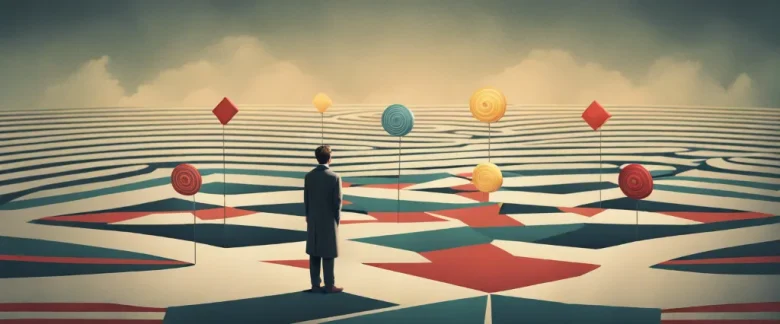In the thought-provoking book “Finite and Infinite Games,” James P. Carse invites readers on a philosophical journey that challenges conventional notions of competition, life, and purpose. Through a concise exploration of finite and infinite games, Carse skillfully examines the contrasting mindsets that govern our actions and shape our existence. As a Professor Emeritus of History and Literature of Religion at New York University, Carse brings his extensive background in theology, philosophy, and literature to illuminate the profound insights hidden within the fabric of everyday life. Join us as we delve into the realms of play, power, and possibility, and discover a new perspective on how we navigate the intricate games of life.
Chapter 1: The Finite Game: The Game of Life
Chapter 1 of “Finite and Infinite Games” by James P. Carse introduces the concept of two fundamental types of games: finite and infinite games. The chapter begins by defining games as voluntary activities with rules that can be observed collectively. Carse then explains that finite games have a predetermined set of rules, fixed boundaries, agreed-upon objectives, and a clear endpoint, whereas infinite games have no fixed rules, no boundaries, and no specific objective or endpoint.
In the finite game of life, individuals participate with the intention of winning by following the established rules and achieving a specific goal. These games have clear winners and losers, and the focus is on controlling the outcome rather than on the enjoyment of playing.
Carse highlights that finite games are fundamentally self-terminating, as their main goal is to reach an endpoint within a fixed timeframe. Once the game is over, the players have no further relationship with each other. He contrasts this with infinite games, where players continue playing indefinitely, deriving purpose and meaning from the act of playing itself. In infinite games, the focus is not on winning or losing, but on ensuring the continuation of the game.
The chapter concludes by suggesting that although many aspects of life seem to resemble finite games, it is essential to recognize the underlying infinite game. Carse asserts that embracing the mindset of an infinite player can bring joy, fulfillment, and a deeper understanding of life, allowing individuals to navigate the uncertainties and challenges of existence without being bound by the finite rules that limit us.
Overall, Chapter 1 initiates the concept of finite and infinite games, highlighting the existence of both types in life and encouraging the reader to consider adopting an infinite mindset to experience a more meaningful and purposeful existence.
Chapter 2: The Infinite Game: The Game of Possibility
Chapter 2 of “Finite and Infinite Games” by James P. Carse delves into the concept of the infinite game, specifically focusing on the game of possibility. Carse explains that while finite games have defined rules, players, and an endpoint, infinite games are framed by an entirely different set of parameters.
In the infinite game of possibility, there are no predetermined rules or specific players. Instead, participants are encouraged to “expand the horizon of possibility” and constantly create new rules and players as the game progresses. Unlike finite games that seek to identify winners and losers, infinite games are more concerned with continuing the game itself. The aim is to embrace uncertainty and continually push the boundaries of what is deemed possible.
Carse emphasizes that the infinite game of possibility is not about achieving a fixed outcome, but rather about fostering ongoing growth and innovation. He suggests that this mindset is found in various aspects of life, such as science, art, and relationships, where the focus is on continuous creativity and advancement.
Furthermore, Carse highlights the importance of acknowledging that the finite games we engage in are mere moments within the broader infinite game. By understanding the infinite game of possibility, individuals can approach finite games with a more elevated perspective, knowing that they are part of something greater and not limited by the constraints of a specific game.
In conclusion, Chapter 2 introduces the concept of the infinite game of possibility. It challenges the traditional notion of games with set rules and endpoints, emphasizing the importance of continually pushing boundaries, embracing uncertainty, and fostering growth and creativity. By adopting an infinite game mindset, individuals can approach various aspects of life with a more expansive perspective.
Chapter 3: The Nature of Finite and Infinite Games
Chapter 3 of James P. Carse’s book, Finite and Infinite Games, explores the contrasting qualities and concepts of finite and infinite games. Carse begins by emphasizing that unlike finite games, which have clear endpoints or winners and losers, infinite games are played without concluding actions. Infinite games are characterized by an ongoing play, where participants aim to prolong the game rather than win it. In contrast, finite games have defined rules, boundaries, and specific outcomes.
Carse argues that finite players play to win and are heavily invested in outcomes, whereas infinite players play for the sake of playing. Finite players see rules as fixed and unquestionable, whereas infinite players constantly challenge and change the rules. Finite players focus on the scoreboard, while infinite players are more concerned with the overall experience and the transformative nature of the game.
Finite games depend on the boundaries that separate players and define the game, highlighting the finite nature of their existence. On the other hand, infinite games erase boundaries, seeking to include as many players as possible and extend the game indefinitely. Infinite games require a more open and accepting approach and aim to cultivate relationships among players.
Carse also explains that the understanding of a game as either finite or infinite is subjective. One person’s finite game may be seen as infinite by another. Recognizing that one is playing a finite game allows individuals to make choices about how and why they participate, and perhaps even opt-out when they no longer find the game fulfilling or meaningful.
In summary, Chapter 3 delves into the fundamental differences between finite and infinite games. While finite games revolve around winning and have predetermined boundaries, infinite games focus on continuous play and aim to include as many participants as possible. Understanding the nature of these games allows individuals to make intentional choices about their participation and find deeper meaning in their playing experiences.
Chapter 4: The Rules of Finite Games

Chapter 4: The Rules of Finite Games from the book Finite and Infinite Games by James P. Carse explores the essential characteristics and rules of finite games. Carse emphasizes that finite games are defined by their boundaries, fixed rules, and the desire for victory within a specific timeframe.
The chapter begins by highlighting the idea that finite games are played within a predetermined framework, which offers both structure and limitation. Players must agree to these rules and abide by them throughout the game. The boundaries of finite games create a clear distinction between the inside, where the game takes place, and the outside, where players are not engaged in the game’s actions.
Carse introduces two primary rules found in finite games: “One must play, and one may not play alone.” The first rule states that participants are required to actively participate in the game, while the second rule asserts that no one can play a finite game by themselves. The existence of others is essential for the game to function and have meaning.
Furthermore, finite games have a clear endpoint or conclusion, marked by a visible winner and loser. Success in a finite game is typically measured by obtaining a specific objective or overcoming one’s opponents. The game ends when the objective is reached or when one player prevails over all others, leading to victory.
Carse elucidates that finite games are characterized by seriousness, as players strive to achieve victory and avoid defeat. The seriousness arises from the desire to preserve the integrity of the game and ensure that it remains within its predetermined boundaries.
In summary, Chapter 4 explores the defining characteristics of finite games, including their fixed rules, boundaries, requirement of multiple participants, and their endpoint marked by a victor. The seriousness displayed during finite games stems from the players’ desire to succeed within the established framework.
Chapter 5: The Rules of Infinite Games
Chapter 5 of James P. Carse’s book “Finite and Infinite Games” explores the nature of infinite games and discusses the rules by which they are played. Carse defines an infinite game as one in which the purpose is to continue the play itself, rather than to win or end the game. These games have no fixed boundaries or time limits; they are played solely for the sake of playing.
According to Carse, the first rule of an infinite game is that players must freely choose to participate. In contrast to finite games, where participants are often forced or coerced into playing, infinite games require players who are willing and committed to engaging in the ongoing play.
The second rule is that infinite games require that the rules themselves be changeable. Unlike finite games with fixed, unchanging rules, infinite games embrace the notion that the rules can be altered, expanded, or abandoned altogether. This flexibility allows the game to evolve and adapt over time, enabling players to continue playing indefinitely.
Carse also emphasizes the importance of being aware of the boundaries within an infinite game. While finite games have clear boundaries and players constantly struggle to move toward them, the boundaries of infinite games are constantly shifting and expanding. Participants must remain alert and adaptable, recognizing that the boundaries are not rigid or fixed, and that new possibilities and potentialities are constantly emerging.
Ultimately, Carse posits that understanding the rules of infinite games is not meant to provide a blueprint for winning, but rather to cultivate a mindset that fully embraces the infinite nature of play. By recognizing the ever-changing boundaries, embracing flexibility, and willingly participating in the ongoing play, players can fully immerse themselves in the beauty and joy of infinite games.
Chapter 6: The Players in Finite and Infinite Games
Chapter 6 of “Finite and Infinite Games” by James P. Carse explores the concept of players in both finite and infinite games. Carse argues that there are two types of players: those who see themselves as part of the game and those who see themselves outside the game.
Infinite players view themselves as part of an ongoing, limitless game, where the goal is to perpetuate the game and keep it going. They do not seek to win or come to a final conclusion. Instead, their aim is to continue playing and ensure the game is sustained. Infinite players are not bound by rules or boundaries and are driven by an inner purpose. They recognize that the game is a gift and are dedicated to its preservation.
On the other hand, finite players see themselves outside the game and engage in play for a specific purpose – to achieve victory. Finite games have defined rules and boundaries, and the players work towards completing the game by meeting its predetermined objectives. They are concerned with outcomes, rankings, and success. Once the goals are achieved, the game ends.
Carse highlights that individuals can switch between being infinite and finite players depending on how they perceive the game. He also reminds us that our choices reflect our deeper understanding of the nature of games and life itself.
The chapter emphasizes the importance of recognizing the difference between finite and infinite play. Carse challenges the reader to consider which type of player they wish to be and how their actions align with their chosen perspective. By questioning our motives and exploring the significance of our actions, we can better navigate the complex nature of games and find deeper meaning in our lives.
Chapter 7: The Purpose of Finite and Infinite Games
Chapter 7 of “Finite and Infinite Games” by James P. Carse dives into the purpose and nature of both finite and infinite games. Carse begins by highlighting the importance of understanding that finite games always exist for the purpose of winning, while infinite games function to continue playing.
He explains that finite games have strict rules and boundaries, defining clear win and lose conditions. These games are engaged in by players who are seeking to be the winner and force their opponents to be losers. The purpose of finite games is to establish and enforce a hierarchy of value, where the victor is seen as superior to the defeated.
On the other hand, infinite games aim to sustain the play itself, with no concern for a final outcome or a hierarchy of value. The purpose of an infinite game is to ensure the continuation of play by embracing and adapting to change. In this type of game, the players are not opponents but fellow participants, where the point is to keep playing, indefinitely.
Carse emphasizes that finite games are often played within an infinite game context, meaning that the ultimate purpose of all activities is to perpetuate the ongoing and infinite plays of life. In recognizing this, one can detach from the need to always win and instead focus on participating fully in the infinite game. This brings a deeper sense of purpose and engagement to one’s actions, allowing them to be part of the transformative and ongoing play of life.
Carse concludes the chapter by highlighting the importance of understanding the purpose of finite and infinite games, as the discovery of purpose is a process of continual evolution within the infinite game itself.

Chapter 8: Embracing the Infinite Game: Living a Life of Possibility
Chapter 8 of “Finite and Infinite Games” by James P. Carse explores the concept of embracing the infinite game and living a life of possibility. Carse argues that while the finite game seeks to win and ends with a victor, the infinite game has no winners or losers and continues indefinitely. In this chapter, Carse encourages individuals to shift their approach from playing finite games to embracing the infinite game.
According to Carse, the infinite game is characterized by the pursuit of possibilities, creativity, and the freedom to shape our own lives. Unlike the finite game, which is bound by rules and guidelines, the infinite game allows individuals to create their own rules and constantly adapt to changing circumstances. It is a game that seeks to expand and involve others, rather than exclude and dominate.
Living a life of possibility within the infinite game requires a deep understanding of oneself and the willingness to let go of fixed identities and predetermined goals. Carse emphasizes that embracing the infinite game means constantly redefining and expanding our horizons, challenging the limitations imposed by society and personal beliefs.
Moreover, Carse encourages individuals to become “infinite players,” who approach life with an attitude of playfulness, curiosity, and an eagerness to discover new possibilities. This involves developing a sense of wonder, embracing uncertainty, and recognizing that life is an open-ended journey without a predetermined destination.
By embracing the infinite game and living a life of possibility, individuals can cultivate a sense of fulfillment and contribute to a greater, more inclusive world. Carse ultimately invites us to transcend the finite game’s narrow focus on winning and instead engage in a lifelong pursuit of exploration, growth, and the expansion of our human potential.
After Reading
In conclusion, James P. Carse’s book “Finite and Infinite Games” provides a profound exploration of life through the lens of finite and infinite games. Carse argues that all aspects of human existence can be seen as either finite games, where players compete to win, or infinite games, where players seek to continue the play. This distinction offers a unique perspective on human interaction, decision-making, and the pursuit of purpose. By understanding the nature of finite and infinite games, readers are encouraged to embrace the infinite perspective and approach life with a sense of playfulness, curiosity, and an appreciation for what lies beyond winning or losing. Ultimately, Carse’s insights challenge the reader to reconsider their own assumptions and strive for a more fulfilling and meaningful existence.
1. The Willpower Instinct” by Kelly McGonigal: This book combines scientific research with practical advice to help you understand and strengthen your willpower. McGonigal explores the psychological and physiological aspects of self-control, offering strategies to overcome temptation, improve focus, and reach your goals.
2. Willpower: Rediscovering the Greatest Human Strength” by Roy F. Baumeister and John Tierney: Baumeister, a leading psychology researcher, dives into the concept of willpower. Drawing on studies and real-life examples, he explains how self-discipline can positively impact various aspects of our lives, including health, relationships, and professional success.
3. The Art of Mental Training: A Guide to Performance Excellence” by D.C. Gonzalez: This book explores the power of the mind in achieving peak performance. Gonzalez, a former professional athlete, provides practical techniques to enhance concentration, manage anxiety, and develop mental resilience. Whether you’re an athlete, student, or professional, this book offers valuable insights for optimizing your performance.
4. Atomic Habits: An Easy & Proven Way to Build Good Habits & Break Bad Ones” by James Clear: Inspired by the concepts of willpower, this book delves into the science of habit formation. Clear introduces practical strategies for making small, incremental changes that lead to significant long-term improvements. By understanding the mechanisms behind habits, you can harness their power to transform your life.
5. Mindset: The New Psychology of Success” by Carol S. Dweck: This influential book explores the power of mindset on personal and professional growth. Dweck differentiates between a “fixed” mindset (believing abilities are innate and unchangeable) and a “growth” mindset (emphasizing the potential for development through effort and learning). By adopting a growth mindset, you can overcome challenges, embrace setbacks, and unlock your true potential.



